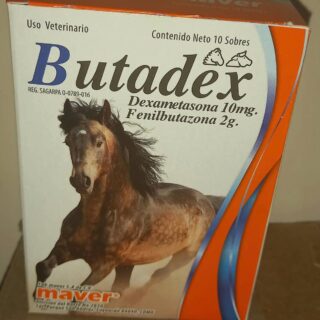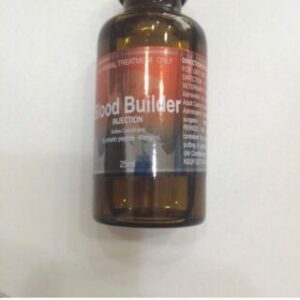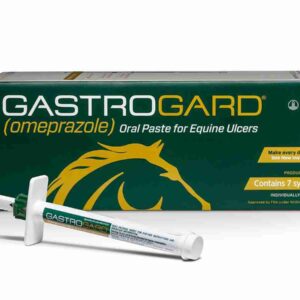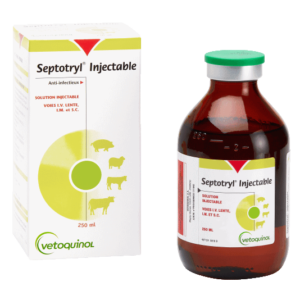Butadex: Overview
Butadex is a veterinary medication commonly used as a non-steroidal anti-inflammatory drug (NSAID). It is primarily used to manage inflammation, pain, and fever in animals, particularly in horses, cattle, and other livestock. The active ingredient in Butadex is typically phenylbutazone, which is a widely used NSAID in veterinary care.
Key Uses of Butadex
- Pain Management: It is commonly prescribed for managing pain associated with:
- Musculoskeletal conditions (e.g., lameness, arthritis, or tendonitis)
- Soft tissue injuries
- Post-surgical recovery
- Inflammation Control: Due to its strong anti-inflammatory properties, it is effective in treating conditions that cause swelling and inflammation, such as:
- Joint inflammation in horses (e.g., osteoarthritis)
- Tendinitis
- Bursitis
- Fever Reduction: It is use to reduce fever in animals, particularly in livestock that may have infections or inflammatory diseases.
- Colic Treatment: In horses, Butadex is sometimes used to manage colic pain, although it is typically combine with other medications that target gastrointestinal function.
Mechanism of Action
The active ingredient in phenylbutazone, works by inhibiting the action of cyclooxygenase (COX) enzymes. These enzymes are responsible for the production of prostaglandins, which play a crucial role in promoting inflammation, pain, and fever in response to injury or infection.
By blocking COX enzymes, Butadex reduces the levels of prostaglandins in the body, leading to decreased inflammation, pain relief, and fever reduction.
Dosage and Administration
The dosage of Butadex varies depending on the species being treated, the severity of the condition, and the veterinarian’s recommendations.
- Horses:
- Oral or Injectable: The typical dose for horses is 1–2 grams of phenylbutazone per day, administered either orally or as an injection, depending on the formulation.
- Short-Term Use: Butadex is often used short-term for acute pain and inflammation. Long-term use should be monitored closely due to potential side effects.
- Cattle:
- NSAID Effect: The dosage for cattle is adjusted based on their weight and condition, with the aim of managing inflammation or pain caused by injury or infection.
- Small Animals:
- In smaller animals like dogs, Butadex is less commonly used due to the availability of more suitable NSAIDs for small animal pain management.
Important: Always follow veterinary advice when administering Butadex. Overdosing or prolonged use without proper guidance can result in serious health issues.
Benefits of Butadex
- Effective Pain Relief: Butadex provides fast and reliable relief from pain caused by musculoskeletal issues, allowing animals to recover more comfortably.
- Anti-Inflammatory Properties: By reducing inflammation, Butadex helps restore normal function in affected joints, tendons, and tissues, improving mobility and overall well-being in animals.
- Fever Reduction: As a fever reducer, Butadex helps control febrile conditions in livestock, especially in cases of infection or systemic inflammation.
- Versatility: Butadex is available in both oral and injectable forms. Making it easy to administer in different situations based on the animal’s condition and treatment needs.
Side Effects and Precautions
While Butadex is an effective medication, it comes with potential risks, especially with prolonged use or in certain animals.
- Gastrointestinal Issues: Like other NSAIDs, Butadex can cause gastric ulcers or gastrointestinal irritation. Particularly with long-term use. This risk is higher in horses, and symptoms include reduced appetite, colic, or diarrhea.
- Kidney and Liver Damage: Prolonged use or high doses can lead to kidney and liver dysfunction. Monitoring of blood work is recommend for animals on long-term Butadex therapy.
- Blood Disorders: Phenylbutazone can lead to bone marrow suppression, causing a reduction in white blood cells. Which can weaken the immune system and make animals more prone to infections.
- Drug Interactions: Butadex can interact with other medications. Including corticosteroids, diuretics, and other NSAIDs, potentially increasing the risk of adverse effects. It’s important to inform the veterinarian about any other medications or supplements the animal is taking.
- Withdrawal Period for Food-Producing Animals: When used in livestock intended for food production. Butadex has strict withdrawal times to ensure no drug residues are present in meat or milk. These times vary by country and should be adhered to carefully to avoid regulatory violations.
Precautions for Use
- Pregnant and Lactating Animals: Butadex should be use cautiously in pregnant or lactating animals. As its safety has not been fully established for these groups.
- Animals with Pre-existing Conditions: Animals with a history of kidney, liver, or gastrointestinal disease should be carefully monitor when using Butadex, and alternative treatments may be considered.
Conclusion
Butadex (Phenylbutazone) is a widely use NSAID in veterinary medicine. Offering effective relief from pain, inflammation, and fever in horses and livestock. It is particularly beneficial for treating musculoskeletal conditions, post-surgical recovery, and managing inflammatory conditions in animals. However, proper veterinary supervision is essential to avoid potential side effects, particularly with long-term use. Following dosage guidelines and monitoring for adverse reactions will help ensure the safe and effective use of this med for managing pain and inflammation in animals.






Reviews
There are no reviews yet.